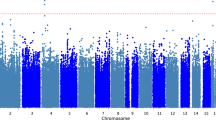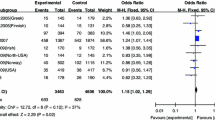Abstract
Introduction
Tardive dyskinesia (TD) has a pharmacogenetic component in which the interaction of antipsychotic exposure with individual genetic variation mediates risk. The glial cell line-derived neurotrophic factor (GDNF) signalling pathway has been associated with neuroprotective effects in central dopaminergic neurons and spinal motor neurons. Clinical trials have also investigated whether GDNF may ameliorate Parkinson’s disease symptoms.
Methods
We tested whether variants in the GDNF receptor alpha 2 (GFRA2) gene could play a role in TD susceptibility evaluating 16 variants in 172 Caucasian schizophrenia subjects.
Results
We observed one significant allelic association (rs4739285, permuted p = 0.042) and two genotypic associations: rs4739285 under additive inheritance model and rs4739217 under dominant inheritance model (permuted p = 0.044). Moreover, carriers of the major alleles for both rs6587002 and rs4739217 presented significantly higher risk for TD (OR = 2.04, permuted p = 0.014), while subjects with the minor allele for rs4739217 and the major allele for rs6988470 were less likely to have TD (OR = 0.21, permuted p = 0.0007).
Discussion
Haplotype results indicate that the minor allele of the rs4739217 is a risk factor for TD (permuted allelic p = 0.074). Age was also a risk factor for TD in our sample (p = 0.0001). Taken together, our findings suggest that GFRA2 genetic variants and age may play a role in TD susceptibility, but further work is required to confirm these findings.

Similar content being viewed by others
References
Airaksinen MS, Saarma M (2002) The GDNF family: signalling, biological functions and therapeutic value. Nat Rev Neurosci 3:383–394
Badner JA, Gershon ES (2002) Meta-analysis of whole-genome linkage scans of bipolar disorder and schizophrenia. Mol Psychiatry 7:405–411
Barker RA (2006) Continuing trials of GDNF in Parkinson’s disease. Lancet Neurol 5:285–286
Barrett JC, Fry B, Maller J, Daly MJ (2005) Haploview: analysis and visualization of LD and haplotype maps. Bioinformatics 21:263–265
Bespalov MM, Saarma M (2007) GDNF family receptor complexes are emerging drug targets. Trends Pharmacol Sci 28:68–74
Borrego S, Fernandez RM, Dziema H et al (2003) Investigation of germline GFRA4 mutations and evaluation of the involvement of GFRA1, GFRA2, GFRA3, and GFRA4 sequence variants in Hirschsprung disease. J Med Genet 40:e18
Bourgeois M (1977) Tardive Dyskinesia induced by neuroleptics: a survey of 3140 patients in a psychiatric hospital. Encephale 3:299–320
Carlsson A, Carlsson ML (2008) Adaptive properties and heterogeneity of dopamine D(2) receptors—pharmacological implications. Brain Res Rev 58:374–378
Casey DE (2004) Pathophysiology of antipsychotic drug-induced movement disorders. J Clin Psychiatry 65(Suppl 9):25–28
Cass WA, Manning MW (1999) GDNF protection against 6-OHDA-induced reductions in potassium-evoked overflow of striatal dopamine. J Neurosci 19:1416–1423
Cass WA, Peters LE (2010) Neurturin effects on nigrostriatal dopamine release and content: comparison with GDNF. Neurochem Res
Durrant C, Zondervan KT, Cardon LR et al (2004) Linkage disequilibrium mapping via cladistic analysis of single-nucleotide polymorphism haplotypes. Am J Hum Genet 75:35–43
Faurbye A, Rasch PJ, Petersen PB, Brandborg G, Pakkenberg H (1964) Neurological symptoms in pharmacotherapy of psychoses. Acta Psychiatr Scand 40:10–27
Fjord-Larsen L, Johansen JL, Kusk P et al (2005) Efficient in vivo protection of nigral dopaminergic neurons by lentiviral gene transfer of a modified Neurturin construct. Exp Neurol 195:49–60
Gauderman WJ (2002) Sample size requirements for matched case-control studies of gene-environment interaction. Stat Med 21:35–50
Gimm O, Dziema H, Brown J et al (2001) Over-representation of a germline variant in the gene encoding RET co-receptor GFRalpha-1 but not GFRalpha-2 or GFRalpha-3 in cases with sporadic medullary thyroid carcinoma. Oncogene 20:2161–2170
Go CL, Rosales RL, Caraos RJ, Fernandez HH (2009) The current prevalence and factors associated with tardive dyskinesia among Filipino schizophrenic patients. Parkinsonism Relat Disord 15:655–659
Grondin R, Gash DM (1998) Glial cell line-derived neurotrophic factor (GDNF): a drug candidate for the treatment of Parkinson’s disease. J Neurol 245:P35–P42
Heuckeroth RO, Enomoto H, Grider JR et al (1999) Gene targeting reveals a critical role for neurturin in the development and maintenance of enteric, sensory, and parasympathetic neurons. Neuron 22:253–263
Hisaoka K, Nishida A, Koda T et al (2001) Antidepressant drug treatments induce glial cell line-derived neurotrophic factor (GDNF) synthesis and release in rat C6 glioblastoma cells. J Neurochem 79:25–34
Hong M, Mukhida K, Mendez I (2008) GDNF therapy for Parkinson’s disease. Expert Rev Neurother 8:1125–1139
Huang RS, Duan S, Bleibel WK et al (2007) A genome-wide approach to identify genetic variants that contribute to etoposide-induced cytotoxicity. Proc Natl Acad Sci U S A 104:9758–9763
Hudson J, Granholm AC, Gerhardt GA et al (1995) Glial cell line-derived neurotrophic factor augments midbrain dopaminergic circuits in vivo. Brain Res Bull 36:425–432
Kramer ER, Aron L, Ramakers GM et al (2007) Absence of Ret signaling in mice causes progressive and late degeneration of the nigrostriatal system. PLoS Biol 5:e39
Lang AE, Gill S, Patel NK et al (2006) Randomized controlled trial of intraputamenal glial cell line-derived neurotrophic factor infusion in Parkinson disease. Ann Neurol 59:459–466
Lavedan C, Licamele L, Volpi S et al (2009) Association of the NPAS3 gene and five other loci with response to the antipsychotic iloperidone identified in a whole genome association study. Mol Psychiatry 14:804–819
Lewis CM, Levinson DF, Wise LH et al (2003) Genome scan meta-analysis of schizophrenia and bipolar disorder, part II: schizophrenia. Am J Hum Genet 73:34–48
Mattson MP, Magnus T (2006) Ageing and neuronal vulnerability. Nat Rev Neurosci 7:278–294
Nanobashvili A, Airaksinen MS, Kokaia M et al (2000) Development and persistence of kindling epilepsy are impaired in mice lacking glial cell line-derived neurotrophic factor family receptor alpha 2. Proc Natl Acad Sci U S A 97:12312–12317
Ohta K, Kuno S, Inoue S et al (2010) The effect of dopamine agonists: the expression of GDNF, NGF, and BDNF in cultured mouse astrocytes. J Neurol Sci
Oo TF, Kholodilov N, Burke RE (2003) Regulation of natural cell death in dopaminergic neurons of the substantia nigra by striatal glial cell line-derived neurotrophic factor in vivo. J Neurosci 23:5141–5148
Remington G (2007) Tardive dyskinesia: eliminated, forgotten, or overshadowed? Curr Opin Psychiatry 20:131–137
Rossi J, Luukko K, Poteryaev D et al (1999) Retarded growth and deficits in the enteric and parasympathetic nervous system in mice lacking GFR alpha2, a functional neurturin receptor. Neuron 22:243–252
Schooler NR, Kane JM (1982) Research diagnoses for tardive dyskinesia. Arch Gen Psychiatry 39:486–487
Shao Z, Dyck LE, Wang H, Li XM (2006) Antipsychotic drugs cause glial cell line-derived neurotrophic factor secretion from C6 glioma cells. J Psychiatry Neurosci 31:32–37
Soler RM, Dolcet X, Encinas M et al (1999) Receptors of the glial cell line-derived neurotrophic factor family of neurotrophic factors signal cell survival through the phosphatidylinositol 3-kinase pathway in spinal cord motoneurons. J Neurosci 19:9160–9169
Souza RP, Romano-Silva MA, Lieberman JA et al (2008) Association study of GSK3 gene polymorphisms with schizophrenia and clozapine response. Psychopharmacology (Berl) 200:177–186
Souza RP, de Luca V, Meltzer HY, Lieberman JA, Kennedy JL (2010a) Influence of serotonin 3A and 3B receptor genes on clozapine treatment response in schizophrenia. Pharmacogenet Genomics 20:274–276
Souza RP, Romano-Silva MA, Lieberman JA et al (2010b) Genetic association of the GDNF alpha-receptor genes with schizophrenia and clozapine response. J Psychiatr Res
Tenback DE, van Harten PN, van Os J (2009) Non-therapeutic risk factors for onset of tardive dyskinesia in schizophrenia: a meta-analysis. Mov Disord 24:2309–2315
Thelma B, Srivastava V, Tiwari AK (2008) Genetic underpinnings of tardive dyskinesia: passing the baton to pharmacogenetics. Pharmacogenomics 9:1285–1306
Tsai HT, Caroff SN, Miller DD et al (2009) A candidate gene study of tardive dyskinesia in the CATIE schizophrenia trial. Am J Med Genet B Neuropsychiatr Genet
Vanhorne JB, Gimm O, Myers SM et al (2001) Cloning and characterization of the human GFRA2 locus and investigation of the gene in Hirschsprung disease. Hum Genet 108:409–415
Weinhold P, Wegner JT, Kane JM (1981) Familial occurrence of tardive dyskinesia. J Clin Psychiatry 42:165–166
Woods SW, Morgenstern H, Saksa JR et al (2010) Incidence of tardive dyskinesia with atypical versus conventional antipsychotic medications: a prospective cohort study. J Clin Psychiatry
Yassa R, Ananth J (1981) Familial tardive dyskinesia. Am J Psychiatry 138:1618–1619
Acknowledgement/Conflict of interest
Canadian Institutes of Health Research (Grant #MOP-49525; Grant #200508GMH, Grant #GMH 79044; Postdoctoral Fellowship 93967 to Dr. Souza, and Clinician-Scientist Phase II fellowship to Dr. Wong). Dr. Souza reports having received a Wyeth/Canadian Institutes of Health Research partnered fellowship.
Author information
Authors and Affiliations
Corresponding authors
Rights and permissions
About this article
Cite this article
Souza, R.P., de Luca, V., Remington, G. et al. Glial cell line-derived neurotrophic factor receptor alpha 2 (GFRA2) gene is associated with tardive dyskinesia. Psychopharmacology 210, 347–354 (2010). https://doi.org/10.1007/s00213-010-1829-4
Received:
Accepted:
Published:
Issue Date:
DOI: https://doi.org/10.1007/s00213-010-1829-4




